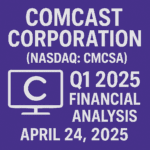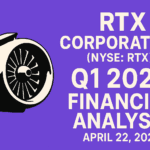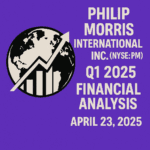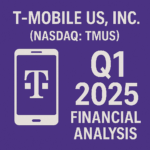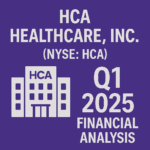Pfizer Inc. (NYSE: PFE)
Q1 2025 Financial Analysis | April 29, 2025
Executive Summary
Pfizer Inc. (NYSE: PFE) reported solid first-quarter 2025 results, demonstrating strong earnings performance despite headwinds from the U.S. Medicare Part D redesign and a continued decline in COVID-19 product revenues. While reported revenues decreased by 8% to $13.7 billion, Adjusted diluted EPS showed a robust 12% growth to $0.92, reflecting the company's successful cost realignment initiatives and operational efficiency improvements. Pfizer has reaffirmed its full-year 2025 financial guidance and announced expanded cost savings targets through 2027, signaling confidence in its ability to navigate the challenging external environment.
Q1 2025 Highlights
Financial Performance
Pfizer's first-quarter 2025 financial results reflect a company in transition, effectively managing the decline in COVID-19 product revenues while driving growth in key non-COVID products. Total revenues decreased by 8% (or 6% operationally) to $13.7 billion, primarily driven by a significant 75% operational decline in Paxlovid revenues. The revenue decrease was influenced by a non-recurring favorable adjustment of $771 million to Paxlovid revenues in Q1 2024, making year-over-year comparisons particularly challenging.
Despite the revenue decline, Adjusted income increased 12% to $5.2 billion, and Adjusted diluted EPS grew by 12% to $0.92. This robust bottom-line performance highlights the company's successful execution of its cost realignment program and operational efficiency initiatives. The significant divergence between top-line and bottom-line results demonstrates management's ability to drive margin improvement in a challenging revenue environment.
Cost of Sales as a percentage of revenues decreased by 2.0 percentage points to 20.7%, driven primarily by a favorable revision of accrued royalties and the positive impact of foreign exchange. This improvement helped offset the unfavorable impact of changes in sales mix and the non-recurrence of the Paxlovid favorable adjustment from Q1 2024.
Selling, informational and administrative (SI&A) expenses decreased by 13% (12% operationally) to $3.0 billion, reflecting ongoing productivity improvements that drove a reduction in marketing and promotional spend across various products and lower spending in corporate enabling functions. Research and development (R&D) expenses also decreased by 12% (11% operationally) to $2.2 billion, primarily due to pipeline focus and optimization, as well as lower compensation-related expenses.
The company's effective tax rate on Reported income for Q1 2025 was negative 6.8%, compared to 8.6% in the prior-year quarter, primarily due to favorable global income tax resolutions in multiple tax jurisdictions spanning multiple tax years, as well as a favorable change in the jurisdictional mix of earnings. The effective tax rate on Adjusted income was 7.8%, down from 16.6% in Q1 2024.
Product Portfolio Performance
| Key Products | Q1 2025 Revenue ($M) | Operational Growth | Key Drivers |
|---|---|---|---|
| Vyndaqel Family | $1,486 | +33% | Strong demand with continuing uptake in patient diagnosis |
| Eliquis | $1,923 | -4% | Lower net price in U.S. due to IRA Medicare Part D Redesign |
| Prevnar Family | $1,660 | -1% | Mixed performance across markets |
| Ibrance | $977 | -6% | Generic entry and timing issues in international markets |
| Comirnaty | $565 | +62% | Higher revenues in U.S. from lower expected returns and higher market share |
| Paxlovid | $491 | -75% | Lower COVID-19 infections and non-recurrence of $771M adjustment in Q1 2024 |
Pfizer's Q1 2025 product portfolio performance revealed mixed results across therapeutic areas, with several key non-COVID products showing strong growth despite headwinds from the Inflation Reduction Act (IRA) Medicare Part D Redesign:
Growth Drivers:
- Vyndaqel family (Vyndaqel, Vyndamax, Vynmac) was a standout performer with 33% operational growth, driven by strong demand with continuing uptake in patient diagnosis, primarily in the U.S. and international developed markets. However, growth was partially offset by lower net price in the U.S. mostly due to the impact of higher manufacturer discounts resulting from the IRA Medicare Part D Redesign.
- Comirnaty showed significant operational growth of 62%, primarily driven by higher revenues in the U.S. reflecting lower expected returns and higher market share, as well as higher contractual deliveries in certain international markets.
- Oncology portfolio delivered impressive growth with products like Padcev (+25%), Nurtec ODT/Vydura (+40%), and Lorbrena (+39%) showing strong operational increases driven by increased market share and expanded indications.
Challenged Products:
- Paxlovid experienced the most significant decline, with revenues down 75% operationally to $491 million. This was primarily due to the non-recurrence of the $771 million favorable final adjustment recorded in Q1 2024, as well as lower COVID-19 infections across U.S. and international markets and reduced international government purchases.
- Eliquis revenues decreased 4% operationally, primarily due to lower net price in the U.S. including the impact of higher manufacturer discounts resulting from the IRA Medicare Part D Redesign. This was partially offset by strong underlying demand and higher revenues in international markets.
- Xeljanz saw a significant 31% operational decline, mostly driven by lower net price in the U.S. due to unfavorable changes in channel mix and the impact of higher manufacturer discounts from the IRA Medicare Part D Redesign.
- Ibrance declined 6% operationally, driven primarily by generic entry and timing of shipments in certain international markets, as well as lower net price in the U.S. mostly due to IRA-related impacts.
The performance highlights Pfizer's ongoing transition from COVID-19 product dependence to growth driven by its core innovative portfolio. However, the significant impact of the IRA Medicare Part D Redesign on net pricing for several key products remains a challenge that the company is actively working to address through its cost realignment and productivity initiatives.
Cost Realignment Program & Productivity Initiatives
A key focus area for Pfizer in Q1 2025 was the continued execution and expansion of its cost realignment program, which is delivering significant operational improvements and offsetting pricing pressures:
Original Cost Realignment Program: Pfizer remains on track to deliver approximately $4.5 billion of net cost savings by the end of 2025, calculated versus the midpoint of Pfizer's 2023 SI&A and R&D expense guidance. These savings are helping to drive the company's operating margin expansion despite revenue headwinds.
Expanded Program Through 2027: The company announced approximately $1.2 billion of additional anticipated savings associated with its ongoing cost realignment program, expected to be achieved by the end of 2027. These additional savings will be driven primarily in SI&A through:
- Enhanced digital enablement, including automation and AI
- Simplification of business processes
- Continued operational efficiencies
R&D Organization Restructuring: Pfizer has expanded its program to include anticipated R&D re-organization cost savings of approximately $500 million by the end of 2026. Unlike the other cost savings, these savings will be reinvested in the pipeline to strengthen future growth prospects.
Manufacturing Optimization Program: The first phase of Pfizer's Manufacturing Optimization Program is on track to deliver approximately $1.5 billion in net cost savings by the end of 2027, with initial savings anticipated in the latter part of 2025. This program aims to reduce the company's cost of goods sold through operational improvements and network optimization.
The total expected one-time costs to implement these initiatives include:
- Approximately $1.6 billion for the additional $1.2 billion SI&A savings through 2027
- Approximately $600 million for the R&D re-organization initiative through 2026
These costs primarily represent cash expenditures for severance, digital enablement, and implementation. The Q1 2025 results already reflect progress on these initiatives, with significant year-over-year decreases in Cost of Sales (16%), SI&A expenses (13%), and R&D expenses (12%).
With these expanded programs, Pfizer now expects total net cost savings of approximately $5.7 billion from the cost realignment program through 2027, plus an additional $1.5 billion from manufacturing optimization. These initiatives are crucial for the company's strategy to improve profitability while navigating the challenging pricing environment brought about by the IRA Medicare Part D Redesign and other market pressures.
Pipeline Developments & R&D Update
Key Regulatory Milestones and Clinical Developments (Q1 2025)
- Abrysvo (RSV Vaccine): The European Commission amended the marketing authorization to extend the indication to include prevention of lower respiratory tract disease caused by RSV in individuals 18 through 59 years of age.
- Adcetris: FDA approval for the supplemental Biologics License Application in combination with lenalidomide and a rituximab product for the treatment of adult patients with relapsed or refractory large B-cell lymphoma.
- Padcev: Presented additional follow-up results from the Phase 3 EV-302 trial evaluating Padcev plus Keytruda in patients with previously untreated locally advanced or metastatic urothelial cancer, showing sustained overall survival and progression-free survival benefits.
- Talzenna: Positive overall survival results from the Phase 3 TALAPRO-2 study in combination with Xtandi in patients with metastatic castration-resistant prostate cancer.
- Sasanlimab: Presented results from the pivotal Phase 3 CREST trial in combination with BCG for high-risk non-muscle invasive bladder cancer, showing a 32% reduction in risk of disease-related events.
- Vepdegestrant: Topline results from the Phase 3 VERITAC-2 trial showed statistically significant improvement in progression-free survival compared to fulvestrant in the estrogen receptor 1-mutant population with advanced breast cancer.
- Danuglipron Discontinued: Decision to discontinue development of the oral GLP-1 receptor agonist for chronic weight management following a review of clinical data and regulatory input.
Pfizer made significant progress strengthening its R&D organization in Q1 2025, including several key leadership appointments that signal the company's commitment to enhancing its pipeline productivity:
- James List, M.D., Ph.D. joined as Chief Internal Medicine Officer, overseeing the company's Internal Medicine portfolio from early discovery to late development. His appointment highlights Pfizer's focus on advancing its emerging pipeline of cardiovascular, metabolic, and obesity medicines.
- Jeffrey Legos, Ph.D., MBA will join as Chief Oncology Officer, leading the company's Oncology R&D and overseeing all functions from pre-clinical to late-stage clinical development activities.
- Patrizia Cavazzoni, M.D. rejoined Pfizer as Chief Medical Officer, Executive Vice President, leading regulatory, pharmacovigilance, safety, epidemiology, and medical information functions.
These leadership changes coincide with the expanded cost realignment program that includes R&D re-organization initiatives expected to deliver approximately $500 million in savings by the end of 2026. Unlike other cost-saving initiatives, these R&D savings will be reinvested in the pipeline to enhance future growth prospects.
While Pfizer continued to advance several key programs in its pipeline, the decision to discontinue danuglipron (an oral GLP-1 receptor agonist for weight management) represents a setback in the company's efforts to enter the rapidly growing obesity market. However, management reaffirmed its commitment to evaluating and advancing promising programs for cardiovascular and metabolic diseases, including obesity.
The pipeline developments in Q1 2025 reflect Pfizer's focus on high-value therapeutic areas, particularly oncology, where multiple programs showed positive clinical results. The company's strategy appears to be shifting toward expanding indications for existing products and advancing late-stage programs with differentiated profiles, while simultaneously streamlining its early-stage pipeline to optimize resource allocation.
Capital Allocation & Balance Sheet
Pfizer's capital allocation strategy in Q1 2025 reflected a balanced approach focused on debt reduction, shareholder returns, and strategic investments:
Shareholder Returns: The company returned $2.4 billion to shareholders through cash dividends ($0.43 per share) in Q1 2025. No share repurchases were completed during the quarter, though Pfizer maintains a $3.3 billion share repurchase authorization. Current financial guidance does not anticipate any share repurchases in 2025.
Research & Development: Pfizer invested $2.2 billion in internal research and development projects during the quarter, reflecting the company's continued commitment to innovation despite overall R&D expense reductions through efficiency initiatives.
Business Development: The company allocated approximately $90 million to business development transactions in Q1 2025. This relatively modest amount suggests a focus on smaller, targeted acquisitions or partnerships rather than large-scale M&A following the significant Seagen acquisition in late 2023.
Debt Management: Pfizer has actively de-levered and as of March 30, 2025, is below its previously stated gross leverage target. The company sold its remaining investment in Haleon plc during Q1 2025, generating approximately $3.3 billion in net proceeds in March (following a previous sale of 700 million Haleon shares in January 2025 for approximately $3.0 billion). These proceeds have contributed to the company's debt reduction efforts.
Looking ahead, Pfizer expects to continue de-levering in a prudent manner while maintaining a balanced capital allocation strategy. This includes preserving the flexibility to deploy capital towards potential value-creating business development transactions and potentially returning capital to shareholders through share repurchases in the future.
The company's focus on debt reduction and maintaining financial flexibility is particularly important given the ongoing revenue challenges from the loss of COVID-19 product sales and pricing pressures from the IRA Medicare Part D Redesign. This disciplined approach to capital allocation supports Pfizer's ability to navigate the current transition period while positioning for future growth.
Outlook & Guidance
Full-Year 2025 Guidance (Reaffirmed)
Management Commentary
Guidance Assessment
Pfizer has reaffirmed all components of its full-year 2025 financial guidance, demonstrating confidence in its ability to navigate ongoing challenges. Notably, CFO David Denton indicated that the company is "currently trending towards the upper end" of its 2025 Adjusted diluted EPS guidance range of $2.80 to $3.00, reflecting strong execution on cost savings initiatives and operational efficiencies.
The company's guidance does not currently include any potential impact related to future tariffs and trade policy changes, which management notes they are unable to predict at this time. This represents a potential risk factor that investors should monitor closely given the evolving global trade environment.
Pfizer's reaffirmation of its full-year 2025 guidance suggests management's confidence in the company's ability to offset revenue headwinds through cost discipline and operational improvements. The guidance range for revenues ($61.0 to $64.0 billion) accommodates continued uncertainty around COVID-19 product sales and the impact of the IRA Medicare Part D Redesign on net pricing for key products.
The Adjusted diluted EPS guidance of $2.80 to $3.00 implies significant margin expansion compared to 2024, highlighting the expected impact of the company's ongoing cost realignment program. With Q1 2025 Adjusted diluted EPS of $0.92 and management's commentary about trending toward the upper end of the guidance range, Pfizer appears to be executing well against its profitability targets despite top-line challenges.
Additional context for the 2025 guidance includes:
- An anticipated unfavorable revenue impact of approximately $0.6 billion due to generic and biosimilar competition for certain products
- Exchange rates based on a blend of actual rates through Q1 2025 and mid-April 2025 rates for the remainder of the year
- Approximately 5.74 billion diluted weighted-average shares outstanding
- No share repurchases anticipated in 2025
The guidance reflects Pfizer's focus on driving operational efficiency while continuing to invest in its pipeline. The maintained R&D expense guidance of $10.7 to $11.7 billion, despite the announced R&D re-organization initiative, underscores the company's intent to reinvest these savings into priority pipeline programs.
While management's overall outlook is cautiously optimistic, they acknowledge the challenge of "navigating an uncertain and volatile external environment." This reflects ongoing macroeconomic uncertainties, potential regulatory changes, and competitive pressures that could impact performance throughout the remainder of 2025.
Risks & Opportunities
Risks
Opportunities
Conclusion
Strengths
- Strong Adjusted diluted EPS growth of 12% despite revenue challenges
- Significant cost reduction across SI&A, R&D, and Cost of Sales
- Robust performance of Vyndaqel family and select oncology products
- On track with cost realignment program targeting $4.5 billion in savings by end of 2025
- Improved tax rate driving bottom-line performance
Focus Areas
- Mitigating impact of IRA Medicare Part D Redesign on key products
- Managing the post-COVID portfolio transition effectively
- Executing on expanded cost savings initiatives through 2027
- Strengthening R&D productivity and pipeline progression
- Balancing cost discipline with strategic investments for future growth
Summary
Pfizer delivered a solid first quarter in 2025, successfully navigating significant headwinds from declining COVID-19 product revenues and pricing pressures from the IRA Medicare Part D Redesign. While reported revenues decreased by 8% to $13.7 billion, Adjusted diluted EPS grew by an impressive 12% to $0.92, highlighting the effectiveness of the company's cost realignment program and operational efficiency initiatives.
The company's performance reflects a business in transition, effectively managing the decline in COVID-19 products while driving growth in key non-COVID franchises such as the Vyndaqel family and select oncology products. Management's decision to expand its cost savings targets, including an additional $1.2 billion in anticipated savings through 2027 and $500 million in R&D re-organization savings by 2026, demonstrates a continued commitment to improving operational efficiency and investing strategically in future growth.
Pfizer's reaffirmation of its full-year 2025 guidance, with management indicating a trend toward the upper end of the Adjusted diluted EPS range, signals confidence in the company's ability to execute its strategy despite a challenging external environment. The company's proactive approach to cost management, strategic R&D investments, and disciplined capital allocation positions it well to navigate the current transition period while building a foundation for sustainable long-term growth.
Source: Pfizer Q1 2025 Earnings Release (April 29, 2025)
